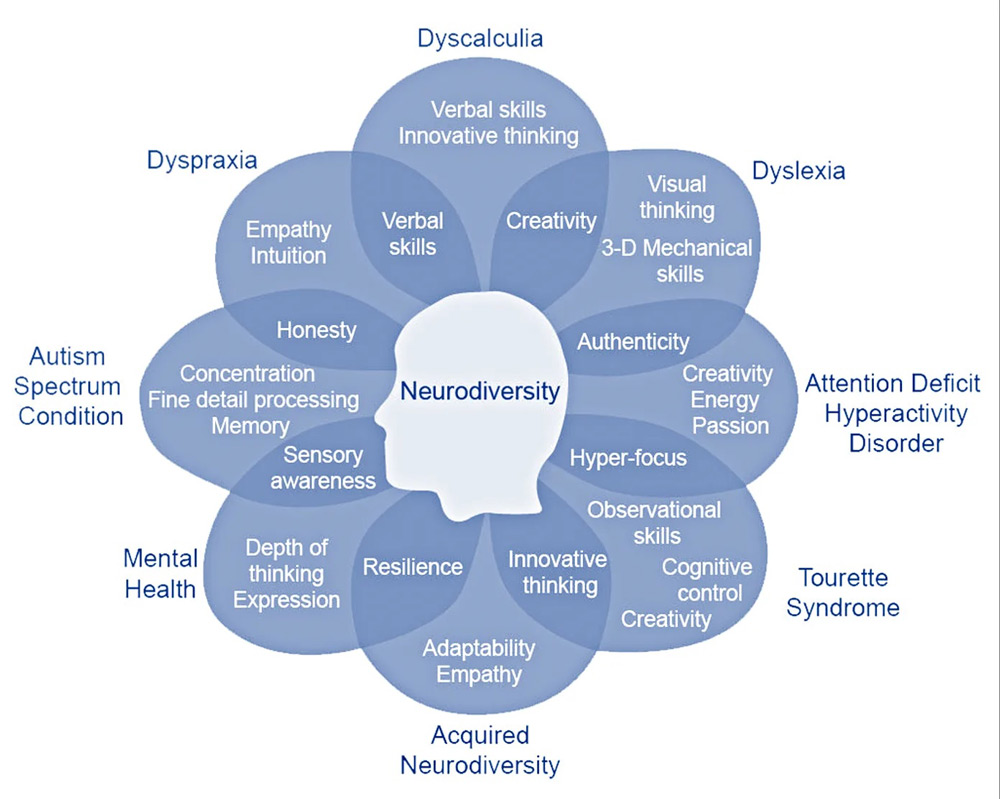Are you neurodivergent?

Would you like to discover how “normal” your brain is or are you neurodivergent?
But before we get going here, let’s define a couple of terms.
Because there is no fixed definition of “normal,” researchers and educators have produced terms to help identify the different assets and challenges that human brains can include. The term “neurodiversity” describes a model for understanding how our brains function and takes the position that diversity is normal, that some brains just work differently.

Neurotypical is the term used to describe people whose brain function and development fall within the “typical” (most often seen and recognized) range.
Neurodivergent (ND for short) is the term used to describe people whose brain function differs in identifiable ways from the typical range. Those of us who identify as neurodivergent may recognize one of the conditions listed below. But since there aren’t any medical criteria or definitions of what it means to be neurodivergent, other conditions can also fall under this term. Here’s a list of what’s typically included:
- Autism spectrum disorder (including what was once called Asperger’s Syndrome)
- ADHD (Attention-deficit hyperactivity disorder)
- Down syndrome
- Dyscalculia (difficulty with math)
- Dysgraphia (difficulty writing)
- Dyslexia (difficulty reading)
- Dyspraxia (difficulty with coordination)
- Intellectual disabilities
- Mental health conditions (bipolar disorder, obsessive-compulsive disorder, etc)
- Prader-Willi syndrome (a rare genetic condition that affects metabolism. PWS causes individuals to have a robust, insatiable appetite so they never feel full after eating)
- Sensory processing disorders
- Social anxiety (a specific type of anxiety disorder)
- Tourette syndrome (identifiable as the result of uncontrollable movements and vocal sounds called tics. TS shows up in early childhood and improves in adulthood)
- Williams syndrome (a rare genetic condition characterized by unique physical features, delays in cognitive development, and potential cardiovascular problems)
ND isn’t a disorder or a defect. ND folks aren’t broken and don’t need “fixing.” Their brains simply work differently, quite frequently in ways that enrich all those within their orbit.
ND folks are incredibly diverse. No two ND individuals, even identical twins, have the same experiences or requirements to be able to live successful, fulfilling lives.

Although some ND people have medical disorders, learning disabilities, and other conditions, vast numbers of ND people do not, and may also boast superior memories, the ability to mentally envision 3D objects easily, the ability to solve complex mathematical calculations in their heads, and other similar gifts.

ND folks may also have difficulty making eye contact or reading body cues, sometimes stuttering is an issue, may have trouble focusing and have issues with self-control and remaining flexible in changing circumstances. They may also have trouble with certain stimuli (light, sound, heat, cold, travel, etc.)
An example of ND versus a typical human brain in everyday life would be comparing the following two people with a talent for playing the violin:
- Person #1: A pre-teen with autism spectrum disorder (ASD) who really struggles in social situations. His main ASD identifiers are social problems coupled with an unusually intense interest in playing the violin; it’s all he wants to do all day. Plus, his teachers say he is naturally better at the violin; taking classes and accumulating experience isn’t as crucial in further developing this extraordinary skill as it would be for a normal kid.


- Person #2: A 40-year-old neurotypical adult; he is comfortable in social situations and makes friends easily. The adult consciously developed the creative skill of playing the violin throughout his life; his talent developed from much education, training, and practice, and took many years to develop.
No one would say that the adult described above is abnormal because he (still) can’t play the violin as well as the pre-teen kid. At the same time, we don’t need to describe the child as anything other than “different,” or “neurodivergent,” since it’s natural for both the adult and the child to develop differently as they deal with their own unique abilities and struggles.
A great many ND people struggle in social situations, which makes it hard to find work because they tend to not have a stellar experience during the job interview. However, if they pass the screening and get the job, their attention to detail keeps them engaged in tasks that neurotypical folks might find tedious (record-keeping, accounting, data analysis, script-writing, coding, drawing, audio editing, etc.).

Some ND struggle simply because some systems and processes don’t give them the chance to highlight their strengths or don’t offer novel, ongoing challenges for them.
Also, some ND people can become overwhelmed in noisy environments or in chaotic, communal situations like open-office designs, emergency rooms, newsrooms, restaurants, backstage at rock concerts, and heavy construction sites. A pair of noise-canceling earpods (when safe) can help them sidestep the distractions so they can focus exclusively on their daily tasks.

Astonishing data point:
An estimated 15-20 percent of the world’s population exhibits some form of neurodivergence.
Are you “on the spectrum”?
The biggest category of NDs is found “on the spectrum;” this refers to the wide range of characteristics and abilities found in individuals with autism.
An example:

- Unique strengths: Your vivid imagination and attention to detail make you an incredible artist. You create beautiful drawings that capture your imaginative world. You seem to have been born with this skill, so learning how to draw was never an issue for you. You’ve seemingly always known how to draw. (Savant: a person with an exceptional natural aptitude in a particular field, like music or mathematics or art, despite being impaired in other areas of intellectual or social functioning.)
- Social challenges: You sometimes struggle to understand others’ emotions or to make friends easily.
- Repetitive behavior: You have an obsessive interest in animals, and you love to learn about unusual species. You can spend all day reading books and watching educational videos about animals and then spend your evenings drawing them.

Every individual on the spectrum has their own set of strengths and challenges, which can vary greatly.
Difficulties with social interactions (understanding emotions or making friends) are common for individuals on the autism spectrum.
Many individuals on the spectrum exhibit repetitive behaviors or intense, even obsessive, interest in specific topics.
Although some ND characteristics (e.g., difficulty with organization, sensory issues) present challenges in traditional work or educational settings, countless ND individuals possess unique strengths that can improve productivity, quality, innovation, and engagement.

By Now You’re Probably Wondering…
If you’ve never thought about neurodivergence in these ways, you may be wondering if your brain is “typical” or if you’re perhaps an undiagnosed member of the ND tribe.
There are probably millions in the ND tribe who have gone unidentified because their unique internal/unspoken challenges haven’t been recognized or identified by their parents, teachers, partners, counselors, or peers.
Or, you may have discovered that someone you know and love may well exist in the ND world, which heretofore has seemed “off limits” or confounding to you.
Either way, here are some things you can do to embrace the ND individuals in your orbit, including yourself, if the above characterizes your lived experience and mindset:
Embrace neurodiversity. Recognize the unique perspectives and talents. Encourage/understand/accept yourself or your loved one as a unique individual.
Discern your/their specific needs so everyone gets the support required.

If you’re a ND type, develop ways to help yourself communicate effectively so you can advocate for yourself as the need arises.
Continue to explore and develop your unique passions so they can help you succeed in the ways you were designed to succeed.

Don’t be afraid to approach neurodivergent individuals in the same way you would neurotypical folks: with an open mind, empathy, and understanding. Ask questions. Get to know them. They will frequently surprise and delight you!
If you’re an employer or a mentor to ND individuals, proactively offer remote work flexibility, Zoom connectivity, noise-canceling earpods, and other options (examples: alternative lighting, full-spectrum, or natural lighting products; written forms, prompts, and instructions; recorded directives, messages, and materials, etc.) that will help them produce with the least amount of personal anguish. (ND conditions are covered by the Americans with Disabilities Act, so reasonable accommodations are to be provided.)
Finally, many who are ND are accomplished and successful. More and more ND people are coming forward and self-identifying, including climate activist Greta Thunberg, oscar-winning actor Sir Anthony Hopkins, musician Florence Welch, scientist Temple Grandin, and Olympic gold medalist Simone Biles.

Experts would also suggest that Nobel Prize-winning chemist Marie Curie and theoretical physicist Albert Einstein, artist Vincent Van Gogh, inventor Nikola Tesla, and author F. Scott Fitzgerald, would today likely identify as ND.

Finally, the Harvard Business Review published an article a few years ago that detailed the benefits of hiring those who are neurodivergent, stating it had been found it was a competitive advantage across many industries.
Great thanks to the National Cancer Institute for many of the insights I’ve expanded upon here, and here are links if you would like to read more:
ceotodaymagazine.com/2022/06/10-highly-successful-people-you-didnt-know-were-neurodivergent/
blog.ongig.com/diversity-and-inclusion/famous-people-with-autism/
